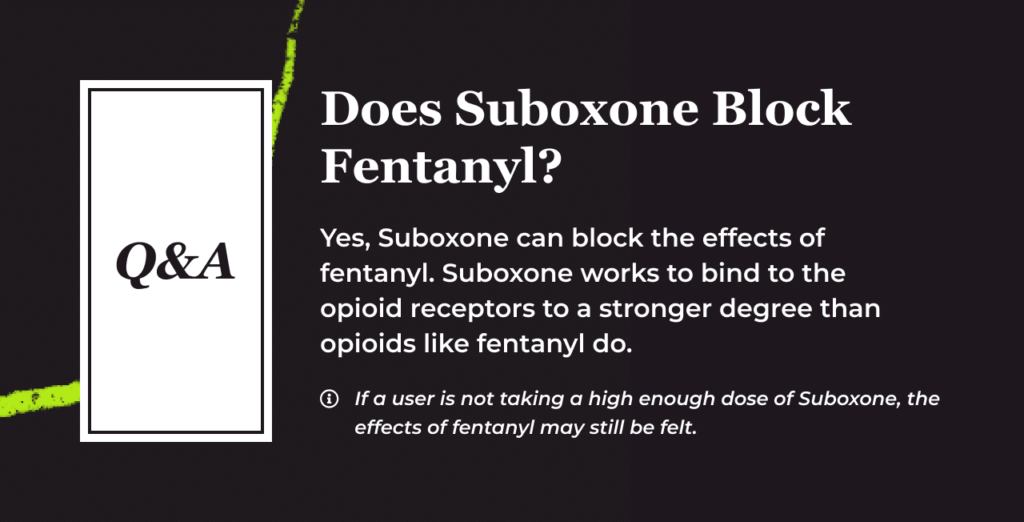Fentanyl is an extremely potent opioid painkiller prescribed to patients who are living with very severe pain, such as pain due to a chronic illness, surgery or end-of-life care. People who are prescribed fentanyl are unable to find relief from any other source, including other commonly prescribed opioid painkillers like oxycodone.[1]
Fentanyl is a highly addictive substance. It works by binding to opioid receptors in the brain to simultaneously block pain signals and trigger the pleasure pathway.
When a person who has been misusing fentanyl stops taking the drug and begins a Medication for Addiction Treatment program for opioid use disorder (OUD), Suboxone can block the fentanyl from being effective if relapse occurs.

Does Suboxone Block the Effects of Fentanyl?
Yes, in most cases, Suboxone blocks (or at least reduces) the effects of fentanyl if someone takes it while they are actively taking Suboxone as part of MAT.[2]
How Does Suboxone Prevent Fentanyl’s Effects?
Buprenorphine, the active ingredient in suboxone, binds to the opioid receptors in the brain. In doing so, it prevents other incoming opioids (like fentanyl) from binding to those same sites. This can strongly reduce the effects of other opioids.
Does Suboxone Always Block the Effects of Fentanyl?
Fentanyl is an exceptionally strong opioid drug, however. If someone who is actively taking Suboxone also takes a high dose of fentanyl and/or combines fentanyl with other substances like alcohol or sedatives, the Suboxone is not always completely effective.[3] Suboxone may not be effective in preventing fentanyl overdose in these situations:[3]
- The dose of Suboxone is too low, or it has been too long since the last dose.
- The dose of fentanyl is very high in comparison to the dose of Suboxone.
- The person has co-occurring medical issues that complicate the overdose.
- The person takes other substances in combination with fentanyl.
Can You Use Fentanyl While on Suboxone?
No, you should not use fentanyl while taking Suboxone. Even those who are living with an active OUD related to fentanyl misuse should go through a tapering process before they begin to take Suboxone to limit the negative effects of having both drugs in their system at the same time.
Having both fentanyl and Suboxone in the body at the same time can create a unique medical issue, known as precipitated withdrawal. This condition can be overwhelming, and immediate medical treatment is needed.
What Is Precipitated Withdrawal?
Precipitated withdrawal is a medical issue that occurs when someone has both an opioid and a blocking medication in their system at the same time.[4] It is usually far worse than a standard withdrawal process that occurs when someone simply stops taking opioids after dependence has formed.
What Are the Signs of Precipitated Withdrawal?
Precipitated withdrawal is usually defined by a series of sudden and intense withdrawal symptoms that can include the following:[5]
- Gastrointestinal issues, such as cramping, nausea, vomiting and diarrhea
- Heavy sweating
- Dilated pupils
- Runny nose, frequent sneezing and yawning
- Inability to sit still or sleep
- High agitation and anxiety
- High heart rate and/or blood pressure
- Body aches and pains
Getting Help for Fentanyl Addiction
The gold standard in fentanyl addiction treatment is MAT which utilizes Suboxone as well as therapeutic support. This is the most heavily studied and well-understood method of treatment for OUD, and it has decades of positive results to support its use.
Bicycle Health offers MAT with Suboxone via our innovative telehealth services. You can meet with an addiction expert from the comfort of your own home, making MAT accessible no matter where you live. You can often get a same-day prescription for Suboxone that you can fill at your local pharmacy.
If you would like to learn more about how to begin, contact us today.

Reviewed By Peter Manza, PhD
Peter Manza, PhD received his BA in Psychology and Biology from the University of Rochester and his PhD in Integrative Neuroscience at Stony Brook University. He is currently working as a research scientist in Washington, DC. His research focuses on the role ... Read More
- The facts about fentanyl. Centers for Disease Control and Prevention. Published September 6, 2023. Accessed December 19, 2023. https://www.cdc.gov/stopoverdose/fentanyl/index.html
- Higher buprenorphine doses associated with improved retention in treatment for opioid use disorder. Brown University: News from Brown. Published September 18, 2023. Accessed December 19, 2023. https://www.brown.edu/news/2023-09-18/buprenorphine-dose
- Fentanyl is so potent doctors don’t know how to fight it. PBS NewsHour. Published December 11, 2017. Accessed December 10, 2023. https://www.pbs.org/newshour/science/fentanyl-is-so-potent-doctors-dont-know-how-to-fight-it
- Varshneya, N; Thakrar, A; Hobelmann, G; Dunn, K; Huhn, A. Evidence of buprenorphine-precipitated withdrawal in persons who use fentanyl. Journal of Addiction Medicine. 16(4):p e265-e268, 7/8 2022. https://journals.lww.com/journaladdictionmedicine/abstract/2022/07000/evidence_of_buprenorphine_precipitated_withdrawal.25.aspx
- Management and Prevention of Opioid Withdrawal. Rutgers Biomedical and Health Sciences. Accessed December 19, 2023. https://njms.rutgers.edu/departments/psychiatry/documents/2020/lc/Management%20and%20Prevention%20of%20Opioid%20Withdrawal%20Slides_Final.pdf
Download Our Free Program Guide
Learn about our program, its effectiveness and what to expect
Related Content
Imagine what’s possible on the other side of opioid use disorder.
Our science-backed approach boasts 95% of patients reporting no withdrawal symptoms at 7 days. We can help you achieve easier days and a happier future.
